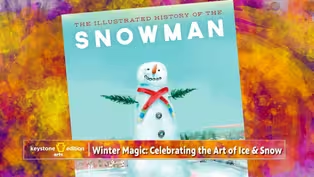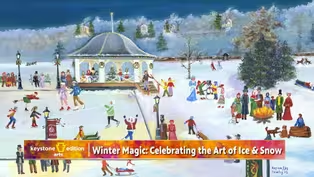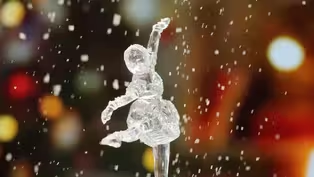Keystone Edition
It's a Wonderful Life - Mary Beth Voda
Clip: 12/23/2024 | 7mVideo has Closed Captions
Mary Beth Voda shares the local connection to the film It's A Wonderful Life
Mary Beth Voda shares the local connection to the film It's A Wonderful Life
Problems playing video? | Closed Captioning Feedback
Problems playing video? | Closed Captioning Feedback
Keystone Edition is a local public television program presented by WVIA
Keystone Edition
It's a Wonderful Life - Mary Beth Voda
Clip: 12/23/2024 | 7mVideo has Closed Captions
Mary Beth Voda shares the local connection to the film It's A Wonderful Life
Problems playing video? | Closed Captioning Feedback
How to Watch Keystone Edition
Keystone Edition is available to stream on pbs.org and the free PBS App, available on iPhone, Apple TV, Android TV, Android smartphones, Amazon Fire TV, Amazon Fire Tablet, Roku, Samsung Smart TV, and Vizio.
Providing Support for PBS.org
Learn Moreabout PBS online sponsorshipHerman spent much of his childhood in Wilkes-Barre.
And so it's fascinating to me that we have that connection with the connection we're going to talk about with you, Mary Beth Voda.
You can tie a film like "It's a Wonderful Life" to our area.
Welcome, and tell us how.
- Hi, yes, "It's a Wonderful Life" has, you could say it start in Wyalusing, Pennsylvania, a tiny little rural community in Bradford County of about, the borough has about 500 residents.
In 1900, the man who wrote "The Greatest Gift" upon which "It's a Wonderful Life" was based, Philip Van Doran Stern was born in Wyalusing in September of 1900.
That picture right there is a picture of one of the places he lived, that was in Tunkhannock.
This is his mother, Anna Stern, Anna Fisher, or excuse me, Anna Fisher Van Doren Stern was his mother.
And this is a picture of Philip, first with his mother and then Philip alone, they lived in Wyalusing briefly, but why he was born here fascinated me.
I heard about it in 2004 from a local newspaper story.
And I was curious, it wasn't explained why he was born here.
His parents were from New Jersey, his father was actually from Bavaria, but his parents were married in New York City in 1899.
And when Philip was due to be born, his mother wanted to be in Wyalusing.
I thought that was odd.
I wondered about it.
Eventually I found out about why he was born here.
It seems his mother trained as a nurse in Philadelphia, and while she was training, she met some people and took care of people from Wyalusing.
When it came time for her to deliver her first child, she wanted to be among those friends in Wyalusing.
Her husband was a traveling salesman, a traveling merchant.
She apparently figured she might be alone at the time of the birth, and she wanted to be surrounded by friends that she cared for.
And that's why they came to Wyalusing and rented a house in downtown Wyalusing borough.
- Well Mary Beth, we know that the Dietrich Theater in Tunkhannockevery year screens "It's a Wonder Life" and people come out, it's for free, and people feel all ready for the holiday, but many of them come out and say, "Well no, no, it's not Seneca Falls."
Bedford Falls is right here in Tunkhannock.
Do you get a sense of anything like that to Tunkhannock when you see the film or when you read "The Gift?"
- It's curious.
They're small towns.
They're very small towns.
Bedford falls in the movie or "The Greatest Gift," the community that Philip Van Doren Stern wrote about was a small town, and it's about small town people, people who are neighbors, people helping each other, people who are, in Stern's view, insignificant.
He wrote a story about what he considered an insignificant person and went on to say that no life is insignificant, they all matter.
And that's, I guess, the connection.
Now there are all kinds of conjectures about, is it really based on Wyalusing?
Well maybe not specifically, but the town that it might be a little closer related to is Sara, or excuse me, Seneca Falls in upstate New York.
And that's a whole other story, but that's connected to.
- Mary Beth, Bob just was telling us about the use of snow in films and how it can go to signify things.
Do you have some insights into the way Frank Capra used snow in the film?
- Right, and it was interesting to hear Bob talk about another film, Frank Capra in 1946, when he produced the movie and directed the movie, didn't want Corn Flakes, he said they were too noisy.
He felt they weren't the right consistency, they weren't the right kind of snow for his movie.
And so he put people on the job and they came up with a mixture of foamite, which was a firefighting chemical mixed with water, soap, and sugar.
And then it was sprayed and pumped through a wind machine onto the people.
If you look at, I just saw that one picture with the lady with the snowflakes on her shoulder.
They're not melting.
I mean, they're right there.
And whatever this foamite mixture was brought the right texture and right consistency to what Frank Capra envisioned.
- Bob, do you have any sense when you watch "It's a Wonderful Life" about the snow and how much that contributes to the effect of the story?
- Exactly, I was gonna ask Mary if she agreed that it's actually a part of the movie that's another cast member in that directors use the pace and speed of the snow to create the mood that they want.
And we see it in animation now in the classic specials like "The Grinch" and "Charlie Brown Christmas," they will use the pace of the snow to sort of control the emotions they want from the viewers.
It's almost an extra person on the screen.
- That's so great.
And another part of, or at least I agree, certainly, another part of it is they were filming in 90 degree temperatures in Hollywood.
And if you look very carefully, as I've read, you could see the perspiration on Jimmy Stewart.
They were really acting.
I mean, they used their acting chops to envision this or to present this story in the frigid cold snowflakes that were falling around them when it was actually 90 degrees.
- It does look like fake snow though.
I'm disappointed when I see "Citizen Kane" that the Snowman looks like it's made of styrofoam, and that's a disappointment.
But we've come a long way.
History of the Snowman - Bob Eckstein
Video has Closed Captions
Clip: 12/23/2024 | 7m 35s | Bob Eckstein shares the history of the snowman in popular culture (7m 35s)
Preview: 12/23/2024 | 30s | Watch Monday, December 23rd at 7pm on WVIA TV (30s)
Providing Support for PBS.org
Learn Moreabout PBS online sponsorship
- News and Public Affairs

Top journalists deliver compelling original analysis of the hour's headlines.

- News and Public Affairs

FRONTLINE is investigative journalism that questions, explains and changes our world.












Support for PBS provided by:
Keystone Edition is a local public television program presented by WVIA


